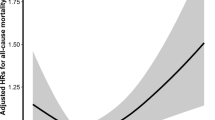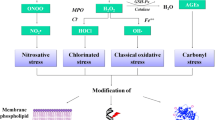Abstract
Purpose
End-stage renal disease patients on chronic hemodialysis (HD) have a shortened life expectancy compared to the general population. The aim of this study was to evaluate a possible link between three new and emerging factors in renal pathophysiology: Klotho protein, telomere length in peripheral blood mononuclear cells (TL) and redox status parameters before HD (bHD) and after HD (aHD), and to test mortality prediction capability of these emerging parameters in a population of HD patients.
Methods
The study included 130 adult patients with average age 66 (54–72), on HD (3 times per week; 4–5 h per session). Klotho level, TL, routine laboratory parameters, dialysis adequacy and redox status parameters: advanced oxidation protein products (AOPP), prooxidant–antioxidant balance (PAB), superoxide anion (O2.−), malondialdehyde (MDA), ischemia-modified albumin (IMA), total sulfhydryl group content (SHG), and superoxide dismutase (SOD) were determined.
Results
Klotho concentration was significantly higher aHD; 68.2 (22.6–152.9) vs. bHD 64.2 (25.5–119.8) (p = 0.027). The observed increase in TL was not statistically significant. AOPP, PAB, SHG, and SOD activity were significantly increased aHD (p > 0.001). The patients with the highest mortality risk score (MRS) had significantly higher PAB bHD (p = 0.002). Significantly lower O2.− (p < 0.001), SHG content (p = 0.072), and IMA (p = 0.002) aHD were found in patients with the lowest MRS values. Principal component analysis revealed redox balance-Klotho factor as a significant predictor of high mortality risk (p = 0.014).
Conclusion
Decreased Klotho and TL attrition as well as redox status disturbance could be connected with higher mortality rate in HD patients.
Similar content being viewed by others
Data availability
The data supporting this study’s findings are available from the corresponding author upon reasonable request.
References
KDIGO 2012 Clinical Practice Guideline for the Evaluation and Management of Chronic Kidney Disease https://kdigo.org/wpcontent/uploads/2017/02/KDIGO_2012_CKD_GL.pdf. Accessed 22 Feb 2021
Buchanan S, Combet E, Stenvinkel P, Shiels PG (2020) Klotho, aging, and the failing kidney. Front endocrinol 11:560
Kuro-o M (2019) The Klotho proteins in health and disease. Nat Rev Nephrol 15:27–44
Zou D, Wu W, He Y, Ma S, Gao J (2018) The role of klotho in chronic kidney disease. BMC Nephrol 19:285
Dalton GD, Xie J, An S-W, Huang C-L (2017) New insights into the mechanism of action of soluble klotho. Front Endocrinol 8:323
Typiak M, Piwkowska A (2021) Antiinflammatory actions of klotho: implications for therapy of diabetic nephropathy. Int J Mol Sci 22:956
Nitta K, Nagano N, Tsuchiya K (2014) Fibroblast growth factor 23/klotho axis in chronic kidney disease. Nephron Clin Pract 128:1–10
Ling XC, Kuo KL (2018) Oxidative stress in chronic kidney disease. Ren Replace Ther. https://doi.org/10.1186/s41100-018-0195-2
Kao MP, Ang DS, Pall A, Struthers AD (2010) Oxidative stress in renal dysfunction: mechanisms, clinical sequelae and therapeutic options. J Hum Hypertens 24:1–8
Kotur-Stevuljevic J, Simic-Ogrizovic S, Dopsaj V, Stefanovic A, Vujovic A, Ivanic-Corlomanic T et al (2012) A hazardous link between malnutrition, inflammation and oxidative stress in renal patients. Clin Biochem 45:1202–1205
Kotur-Stevuljević J, Vekić J, Stefanović A, Zeljkovic A, Ninic A, Ivanisevic J et al (2020) Paraoxonase 1 and atherosclerosis-related diseases. BioFactors 46:193–205
Wills LP, Schnellmann RG (2011) Telomeres and telomerase in renal health. J Am Soc Nephrol 22:39–41
Cawthon RM (2002) Telomere measurement by quantitative PCR. Nucleic Acids Res 30:e47
Witko-Sarsat V, Nguyen M, Capeillere-Blandin C, Nguyen-Khoa T, Nguyen AT, Zingraff J et al (1996) Advanced oxidation protein products as a novel marker of oxidative stress in uremia. Kidney Int 49:1304–1313
Alamdari DH, Paletas K, Pegiou T, Sarigianni M, Befani C, Koliakos G (2007) A novel assay for the evaluation of the prooxidant-antioxidant balance, before and after antioxidant vitamin administration in type II diabetes patients. Clin Biochem 40:248–254
Auclair C, Voisin E (1985) Nitroblue tetrazolium reduction. In: Greenwald RA (ed) CRC Handbook of Methods for Oxygen Radical Research. CRC Press, Boca Raton, pp 123–132
Girotti MJ, Khan N, Mc Lellan BA (1991) Early measurement of systemic lipid peroxidation products in plasma of major blunt trauma patients. J Trauma 31:32–35
Or D, Lau E, Winkler JV (2000) A novel assay for cobalt-albumin binding and its potential as a marker for myocardial ischemia—a preliminary report. Emerg Med J 19:311–315
Ellman E (1959) Tissue sulfhydryl groups. Arch Biochem Biophyus 82:70–77
Misra HP, Fridovich I (1972) Chemistry and metabolism of substances of low molecular weight: the role of superoxide anion in the autoxidation of epinephrine and a simple assay for superoxide dismutase. J Biol Chem 247:3170–3175
Floege J, Gillespie IA, Kronenberg F, Anker S, Gioni I, Richards S et al (2015) Development and validation of a predictive mortality risk score from a European hemodialysis cohort. Kidney Int 87:996–1008
Miljkovic M, Stefanovic A, Simic-Ogrizovic S, Vekic J, Bogavac-Stanojevic N, Cerne D et al (2018) Association of dyslipidemia, oxidative stress, and inflammation with redox status in VLDL, LDL, and HDL lipoproteins in patients with renal disease. Angiology 69:861–870
Navarro-García JA, Rodrígues-Sánchez E, Aceves-Ripoll J, Abarca-Zabalía J, Susmozas-Sánchez A, González Lafuente L et al (2019) Oxidative status before and after renal replacement therapy: differences between conventional high flux hemodialysis and on-line hemodiafiltration. Nutrients 11:2809
Alamdari DH, Honarmand M, Sarrafnajed A, Varasteh R, Parizadeh MR, Ghayour-Mobarhan M et al (2009) Oxidative stress modulation immediately after hemodialysis. Dial Transpl 38:354–358
Tajbakhsh R, Qorbani M, Mehrpour G, Rahimzadeh M, Azimzadeh M, Mirmiranpour H (2017) Effect of hemodialysis on oxidants and antioxidant factors in chronic renal failure. Saudi J Kidney Dis Transpl 28:507–516
Liakopoulos V, Roumeliotis S, Gorny X, Dounousi E, Mertens PR (2017) Oxidative stress in hemodialysis patients: a review of the literature. Oxid Med Cell Longev 2017:3081856
Ma Q (2013) Role of nrf2 in oxidative stress and toxicity. Annu Rev Pharmacol Toxicol 53:401–426
Kiyici A, Mehmetoğlu İ, Karaoğlan H, Atalay H, Solak Y, Türk S (2010) Ischemia-Modified albumin levels in patients with end-stage renal disease patients on hemodialysis: does albumin analysis method affect albumin-adjusted Ischemia-Modified albumin levels? JCLA 24:273–277
Hu MC, Shi M, Zhang J, Addo T, Cho HJ, Barker SL et al (2016) Renal production, uptake, and handling of circulating αKlotho. JASN 27:79–90
Hibah HI, Mutaz SA, Tektook NK, Jabar HA (2020) Serum α-klotho level in patients subjected to hemodialysis in association with lipid profile. Medico-Legal Update 20:1366–1372
Wang Y, Chen S, Feng S, Wang C, Jiang H, Rong S et al (2021) Telomere shortening in patients on long-term hemodialysis. Chronic Dis Transl Med 7:266–275
Carrero JJ, Stenvinkel P, Fellström B, Qureshi AR, Lamb K, Heimbürger O et al (2008) Telomere attrition is associated with inflammation, low fetuin-A levels and high mortality in prevalent hemodialysis patients. J Intern Med 263:302–312
Vukašinović A, Ostanek B, Klisic A, Kafedzic S, Zdravkovic M, Ilic I et al (2021) Telomere-telomerase system status in patients with acute myocardial infarction with ST-segment elevation (STEMI) -relationship with oxidative stress. Arch Med Sci 19:313–323
Stefanidis I, Voliotis G, Papanikolau V, Chronopoulou I, Eleftheriadis T, Kowald A et al (2015) Telomere length in peripheral blood mononuclear cell of patients on chronic hemodialysis is related with telomerase activity and treatment duration. Artif Organs 39:756–764
Ramirez R, Carracedo J, Soriano S, Jimenez R, Martin-Malo A, Rodriguez M et al (2005) Stress-induced premature senescence in mononuclear cells from patients on long-term hemodialysis. Am J Kidney Dis 45:353–359
Annual Data Report | USRDS https://adr.usrds.org/2020/end-stage-renal-disease/5-mortality
Antolini F, Valente F, Ricciardi D, Baroni M, Fagugli RM (2005) Principal component analysis of some oxidative stress parameters and their relationships in hemodialytic and transplanted patients. Clin Chim Acta 358:87–94
Gwozdzinski K, Pieniazek A, Gwozdzinski L (2021) Reactive oxygen species and their involvement in red blood cell damage in chronic kidney disease. Oxid Med Cell Longev 2021:6639199
Kükürt A, Gelen V, Başer ÖF, Deveci HA, Karapehlivan M. Thiols: Role in Oxidative Stress-related disorders. IntechOpen 2021. Available from https://www.intechopen.com/chapters/75841. Accessed 25 Feb 2022
Prakash M, Shetty MS, Tilak P, Anwar N (2009) Total Thiols: biomedical importance and their alteration in various disorders. Online J Heal Allied Sci 8:1–9
Podkowińska A, Formanowicz D (2020) Chronic kidney disease as oxidative stress-and inflammatory-mediated cardiovascular disease. Antioxidants 9:752
Oh HJ, Nam BY, Lee MJ, Kim CH, Koo HM, Doh FM et al (2015) Decreased circulating klotho levels in patients undergoing dialysis and relationship to oxidative stress and inflammation. Perit Dial Int 35:43–51
Acknowledgements
We are grateful to Dr. David R. Jones for his excellent help in English language correction of the manuscript.
Funding
From the Ministry of Education, Science and Technological Development, Republic of Serbia through Grant Agreement with University of Belgrade—Faculty of Pharmacy No: 451-03-47/2023-01/ 200161. The funding organization played no role in study design, in collection, in analysis and in interpretation of data in the writing the report nor in the decision to submit the report for publication.
Author information
Authors and Affiliations
Contributions
All authors have accepted responsibility for the entire content of this manuscript and approved its submission. All authors contributed to: (1) substantial contributions to conception and design, or acquisition of data, or analysis and interpretation of data, (2) drafting the article or revising it critically for important intellectual content, and (3) final approval of the version to be published.
Corresponding author
Ethics declarations
Conflict of interest
The authors declare that they have no conflict of interest.
Ethical approval
This study has complied with all the relevant national regulations, institutional policies and that listed in the Helsinki Declaration of Ethical Principles for Medical Research. The study was approved by the Ethic Committee of “Zvezdara” University Clinical Hospital Center on 22.01.2021.
Informed consent
Informed consent was obtained from all individuals included in this study.
Additional information
Publisher's Note
Springer Nature remains neutral with regard to jurisdictional claims in published maps and institutional affiliations.
Rights and permissions
Springer Nature or its licensor (e.g. a society or other partner) holds exclusive rights to this article under a publishing agreement with the author(s) or other rightsholder(s); author self-archiving of the accepted manuscript version of this article is solely governed by the terms of such publishing agreement and applicable law.
About this article
Cite this article
Milošević, T., Sopić, M., Vekić, J. et al. The influence of Klotho protein and prooxidant–antioxidant balance combination on the mortality of HD patients. Int Urol Nephrol 56, 615–623 (2024). https://doi.org/10.1007/s11255-023-03696-w
Received:
Accepted:
Published:
Issue Date:
DOI: https://doi.org/10.1007/s11255-023-03696-w




